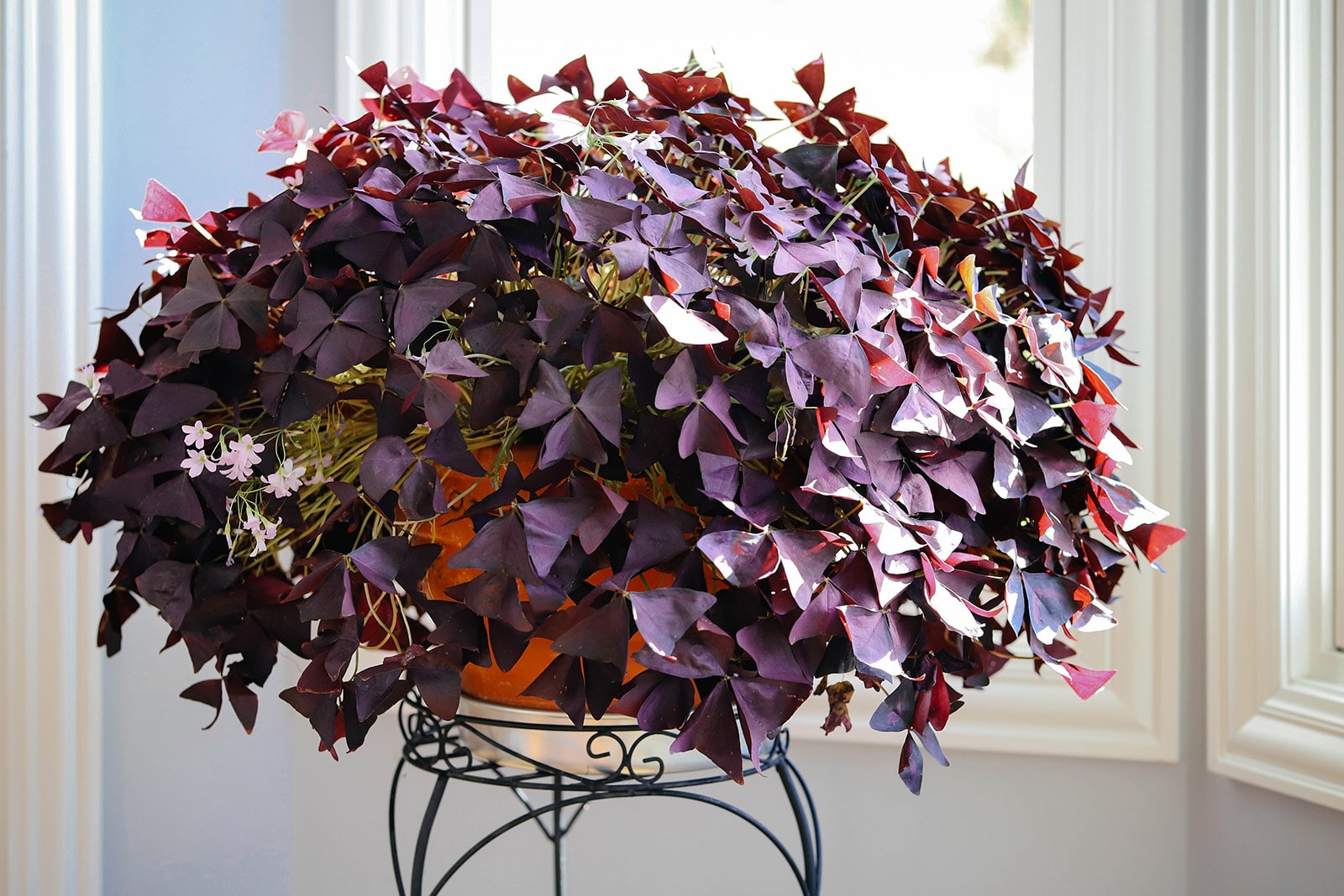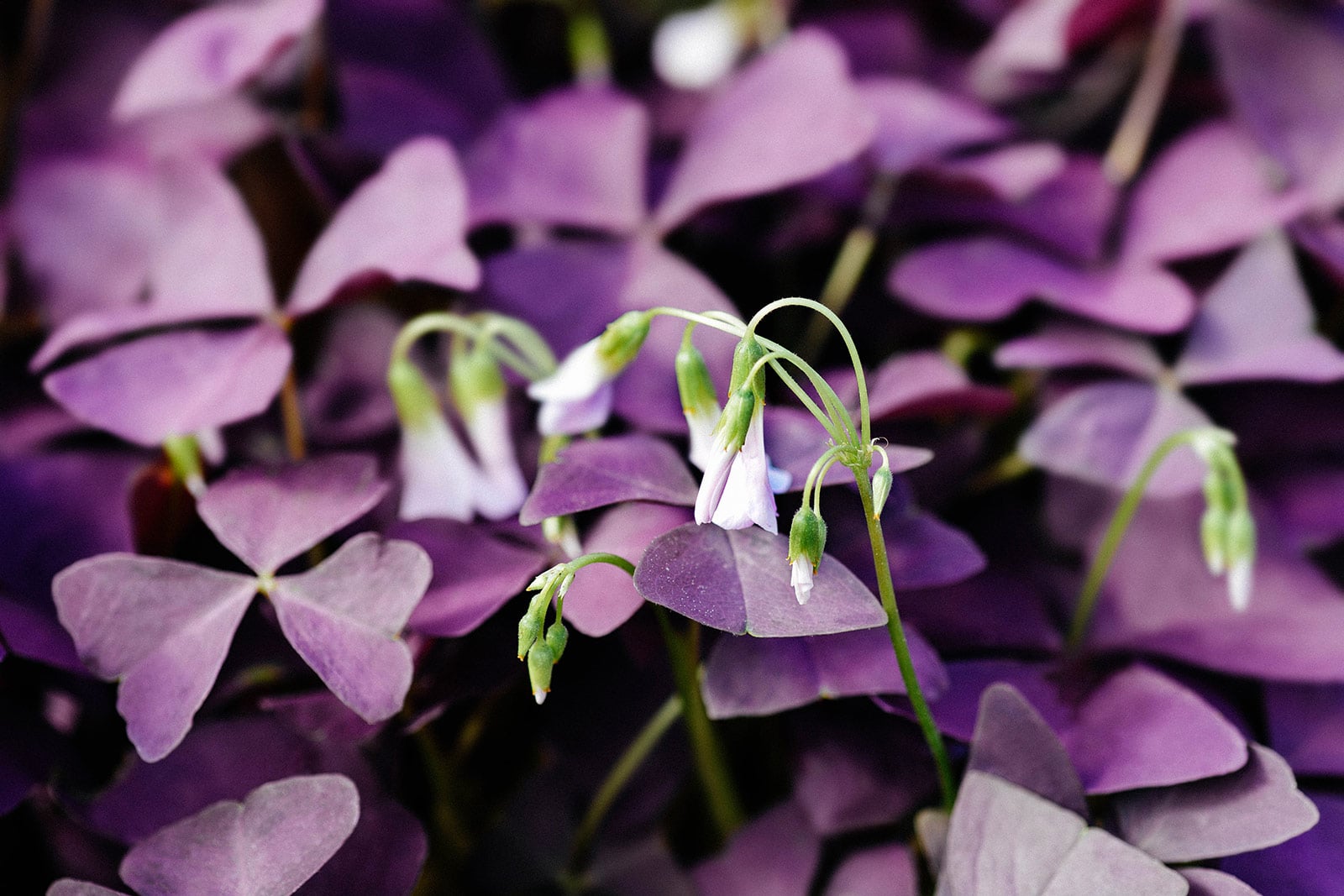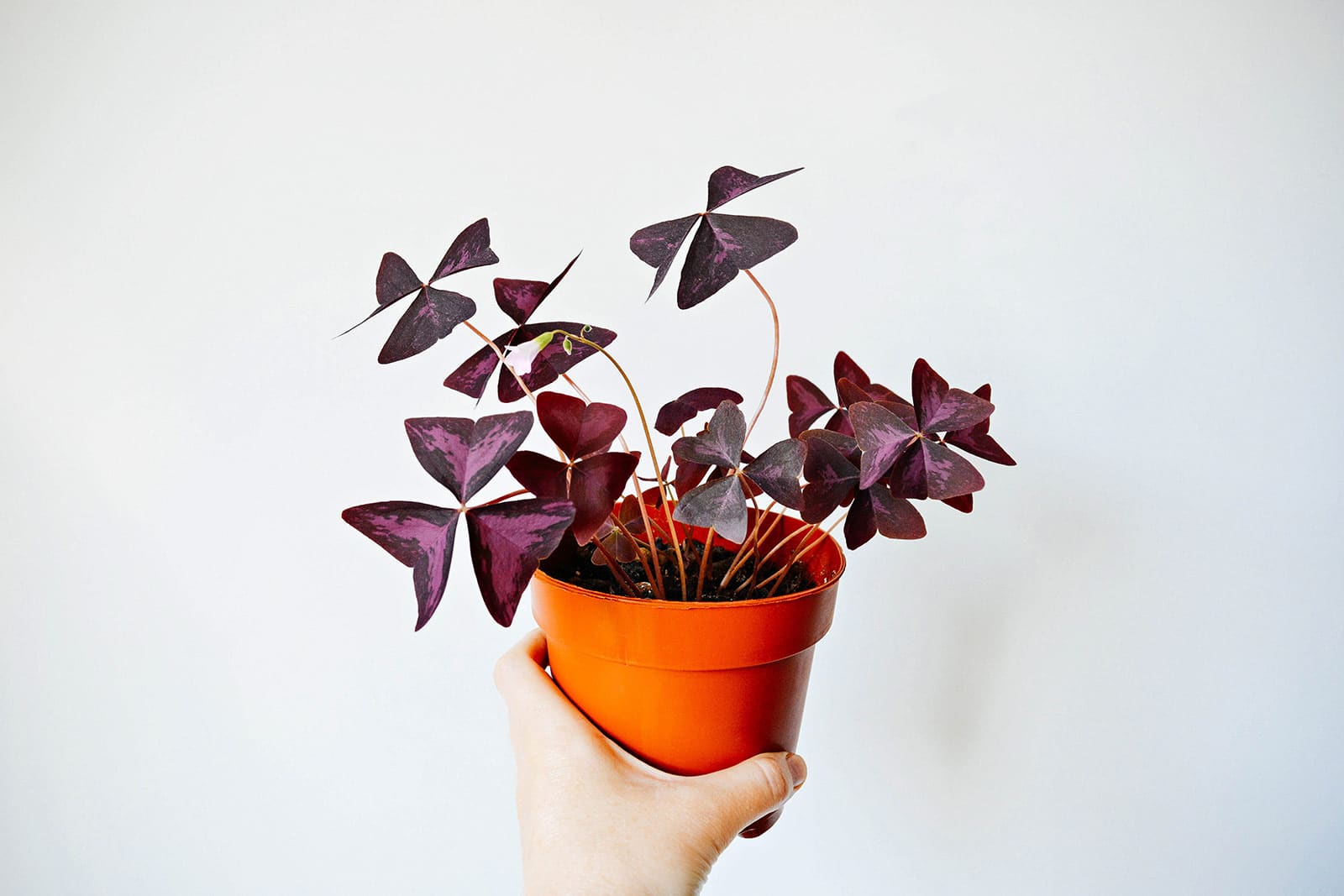Looking for a colorful houseplant to add to your collection? You’ll love Oxalis triangularis, better known as the false shamrock. Its deep purple, butterfly-like foliage makes the perfect addition to any bright windowsill!
Keep reading for everything you need to know about Oxalis triangularis care and growing this charming houseplant indoors.
| Common name(s) | False shamrock, purple shamrock, love plant |
| Scientific name | Oxalis triangularis |
| Family | Oxalidaceae (wood sorrels) |
| Height & spread | Up to 12 inches tall and 24 inches wide |
| Light | Bright indirect |
| Soil type | Moisture-retaining but well-draining |
| Water | Let first 1 to 2 inches of soil dry out |
Disclosure: If you shop from my article or make a purchase through one of my links, I may receive commissions on some of the products I recommend.

About Oxalis triangularis
Natural habitat
The purple shamrock houseplant is naturally found in much of South America, from Brazil down to the northern parts of Argentina. In Brazil at least, it grows in rocky zones by streams and rivers, although it has no problem spreading to areas marked by human activity.
Because Oxalis triangularis is pretty hardy, it’s unsurprising that it has popped up as a naturalized species in various areas. It’s found in a bunch of states in the US (a 2021 report noted it in Arkansas, and it has also been found in Louisiana and Florida), as well as India.
Description
Oxalis triangularis was first scientifically described in 1825 by French botanist Augustin Saint-Hilaire. Although it’s often called a shamrock (which refers to the clover family), that’s not actually what it is.
Instead, Oxalis is a rhizomatous wood sorrel, which grows clusters of leaves from small, pinecone-like corms. This naming confusion has earned it the common name of “false shamrock.”
The false shamrock is adored among houseplant enthusiasts for its trifoliate (three-petaled leaves), which are nyctinastic: They move according to the time of day. When it’s light out, the leaves will open, whereas at night they close up—similar to how prayer plants like Calathea makoyana, Maranta leuconeura, and Stromanthe sanguinea fold up their leaves at night.
False shamrocks are almost like butterflies with their shape and fluttering movements! Small, white to pink flowers add to the species’ whimsical charm.
It’s important to remember that Oxalis triangularis can go dormant, which is characteristic of bulb plants. Younger plants especially may die off yearly. They normally produce foliage and bloom for around half of the year, during the spring, summer, and early fall.
Did you know?
You may find Oxalis plants labeled as Oxalis regnelli. This is the exact same species; the name is an accepted synonym. ‘Regnelli’ is sometimes used to refer specifically to the green version of the plant, but that’s not actually accurate.
Uses and cultural significance
While most people think of purple shamrocks when it comes to Oxalis triangularis houseplants, green varieties are commonly sold around St. Patrick’s Day because they look so much like the classic shamrock. If you’re looking for one, be sure to check out nurseries and garden centers around this time!
Did you know?
Shamrocks aren’t the only houseplants associated with luck and fortune. Chinese money plants have the same reputation, as their circular leaves are reminiscent of coins stacked on top of each other!
Like many of its other wood sorrel cousins (including True French sorrel and red-veined sorrel, which are more commonly grown in vegetable gardens), the false shamrock is noted as being edible. It’s high in oxalic acid, which means you shouldn’t overdo it, but this is what lends a lemony flavor to the leaves and flowers. The corms are also edible, being pleasant and sweet.
Another potential use of Oxalis triangularis is as a natural (food) coloring, something a few studies have explored. Apparently, the pigments (Anthocyanins) can be isolated and used for their attractive purple color.

Oxalis triangularis varieties
Ever since this species became popular as both a houseplant and garden plant, nurseries seem to have been busy creating plenty of cultivars. There are loads of different Oxalis triangularis varieties out there!
Here are the ones I could find, although I’m sure there are more out there:
- Oxalis triangularis sp. Papilionacea: It isn’t always made clear whether this is a subspecies or a scientific synonym, but from my research, I’d say it’s the former. This variety has much larger leaves and also tends to grow taller.
- Oxalis triangularis ‘Mijke’: Reddish-purple leaves and white flowers.
- Oxalis triangularis ‘Atropurpurea’: Almost blackish-purple leaves with lighter purple centers.
- Oxalis triangularis ‘Ebony Allure’: Fully purple-black foliage.
- Oxalis triangularis ‘Fanny’: Fully green leaves and white blooms.
- Oxalis triangularis ‘Sanne’: Leaves are green on top but purple on the bottom.
- Oxalis triangularis ‘Marmer’: Green leaves with lighter, silvery-green centers.
- Oxalis triangularis ‘Amber’: Fully green leaves with pale pink flowers.
- Oxalis triangularis ‘Irish Mist’: Dark and silvery green speckled foliage and white blooms.
- Oxalis triangularis ‘Birgit’: Green leaves and very pale pink blooms.
- Oxalis triangularis ‘Sunny’: Dark purple leaves with a hint of lighter purple in the center.
- Oxalis triangularis ‘Burgundy Wine’: Dark burgundy foliage mottled with slightly lighter coloring.
- Oxalis triangularis ‘Black Velvet’: Almost black foliage.
Where to buy
Oxalis triangularis plants

Caring for Oxalis triangularis
Light and temperature
If you’d like to grow an Oxalis triangularis plant in your home, be sure to place it in a bright spot. False shamrocks that don’t receive enough light can grow leggy and lose their charm, so go for a window that gets plenty of bright indirect light. A little sun won’t be a problem either, though don’t blast the plant without acclimating it first.
In terms of temperature, it can be a little difficult to find the right balance for your Oxalis, especially during the summer months. It has evolved to go dormant if things get too hot, meaning these plants can die off temporarily if your home gets too warm or if yours is close to a heating unit.
Room temperature is fine, although temps down to 55°F shouldn’t be too much of a problem either. If it’s consistently over 75°F, you might find your false shamrock dropping leaves and going into dormancy.
Water and humidity
Watering is another part of Oxalis triangularis care that some houseplant enthusiasts find a little difficult to balance. As I mentioned earlier, this is a rhizomatous plant, and its corms can be sensitive to rot caused by standing water.
On the other hand, if you let things get too dry, you risk your false shamrock thinking the hot and dry season has started and dropping its leaves for a dormancy period. Still, it’s usually better to underwater a little than to overwater it.
During the summer months, you can let the first inch or two of the soil dry out before watering again. In winter, when houseplants don’t need as much water, wait until the soil is about halfway dry. Remember that good drainage is just as important as proper watering habits!
In terms of humidity, this isn’t an overly demanding species. Unless your home is exceedingly dry, you shouldn’t have any trouble in this department.
Soil and planting
Good drainage is essential for rhizomatous plants, because standing water can cause rot to set in on their corms and gradually kill the entire plant.
Luckily it’s not difficult to put together a soil that works well for your Oxalis triangularis: combining a lightweight houseplant potting soil with some perlite for added drainage usually does the trick.
When it comes to planters for false shamrock, some houseplant enthusiasts prefer a hanging pot, but a normal one is also totally fine.
The most important thing is that the planter should always have a hole in the bottom to allow excess water to drain easily. Terracotta planters, which are porous, work well if you tend to overwater. Otherwise, any regular plastic nursery planter with a decorative overpot is perfect.
Recommended products for Oxalis triangularis plant care:
- Good Earth Organics Premium Potting Soil
- FoxFarm Ocean Forest Potting Soil
- Perfect Plants Organic Perlite
Fertilizing
An active Oxalis triangularis can grow pretty quickly during the summer months when there’s lots of light available. If yours is putting out new leaves on a regular basis, it’ll probably appreciate a little extra fertilizer. You can use a diluted regular houseplant fertilizer on a biweekly basis.
Don’t use plant food if your false shamrock isn’t actively growing, especially if it’s dormant (when all foliage is gone). Excess unused fertilizer can damage the corms and roots.
Recommended fertilizers for Oxalis triangularis:
- Houseplant Resource Center Liquid Fertilizer for Houseplants
- Instant Biologics Instant Plant Food (Fizzing Nutrient Tablets)
- Maxsea All-Purpose Seaweed Plant Food
Pruning
Your false shamrock plant won’t need any pruning, though if it drops leaves, you can remove them. You’ll be doing so regularly if yours is transitioning into dormancy.
Dividing or repotting
This is not a houseplant that requires frequent repotting, although it does appreciate some fresh soil on a yearly basis. You can keep it in the same planter until the rhizomes grow too large, at which point you can opt to either divide or repot.
Repotting will get you a larger and larger plant over time, which can be quite a sight to see when an Oxalis triangularis is in full growing mode and very bushy. On the other hand, dividing the corms is an easy way to produce more plants for your own collection or to give away.

Propagating Oxalis triangularis
It’s not difficult at all to propagate your false shamrock plant; as I mentioned above, you can do so through division. Individual leaves do root, but they don’t regrow unless any of the plant’s base is included. The best time to propagate is when your Oxalis is dormant but you’re ready to wake it up (usually around springtime).
Dig out the corms and see what you’ve got to work with. There will usually be more than one, which means there’s no need to break them apart. If you do need to separate bulbs, it’s usually easy enough to do so wherever offsets have begun to appear.
Pot the corms up separately and wake up the plant by providing plenty of light and regular small waterings. Voilà, now you’ve got multiple pots of Oxalis triangularis!

Common questions about Oxalis triangularis care
How should I care for a dormant Oxalis triangularis?
Luckily, a dormant false shamrock doesn’t require special care as some other plants do during their inactive months.
When it’s time for the plant to enter its latent period, you’ll notice it becoming more and more scraggly. Flowers wilt and leaves begin to droop, staying closed permanently rather than opening up every morning. Eventually, the foliage will die off entirely or look so sad you’ll want to just get it over with and cut it off, leaving you with an empty planter.
Worry not: Unless the corms are damaged or dead, your Oxalis has the ability to regrow perfectly fine when it deems the time to be right.
Don’t water a dormant Oxalis triangularis or you run the risk of causing the corms to rot. They’ve got water stored inside them, which is enough to hold them over until the next growing period. Instead, just pop them into a cool, dark and dry closet somewhere, pot and all.
After a few months (usually when spring rolls around), dig up the corms to give them a soak and repot them into fresh soil. Place the planter in a bright location and start watering lightly. New growth should pop up within a few weeks!
Is Oxalis triangularis toxic to cats and dogs?
Not really, since it’s actually edible in small quantities (unless you happen to be sensitive to ailments like gout and kidney stones). The problem is that animals taking a nibble don’t always know when to stop; the oxalic acid content in Oxalis triangularis is known to cause colic in horses, for example.
Overeating the plant can cause stomach issues, so it may just be best to keep it away from your furry friends.
Sources:
- Pazmiño-Durán, E. A., Giusti, M. M., Wrolstad, R. E., & Glória, M. B. A. (2001). Anthocyanins from Oxalis triangularis as potential food colorants. Food Chemistry, 75(2), 211-216.
- De Saint, A. F. C. P. (1829). Flora brasiliae meridionalis (Vol. 2). apud A. Belin.
- SERVISS, B. E., HARDAGE, J. W., & PECK, J. H. OXALIS TRIANGULARIS (OXALIDACEAE) NATURALIZED IN THE ARKANSAS FLORA.
















Linda….
Thank you so much for this article on the Oxalis triangularis plant. I have one that was created from the corms of my grandmothers plant that she started over 70 years ago. Obviously if treated with come TLC they can survive many years of regrowth. Keep up the great newsletters as I enjoy them immensely!!
Respectfully,
Bill Paris
You promised it would be “the last guide needed,” and it does have a lot of info, but alas fell short! I have a number of pots going grown from corms. Among the normal results are several clusters of green leaves. Do you know if triangularis is a sport from a green leaved plant, and these anomalous leaves are reversions that will remain green, or might they over the yrs become purple? I can keep pinching them at soil level, but obviously can’t dig up the corm without disturbing the others. Thanks for your help and the article.